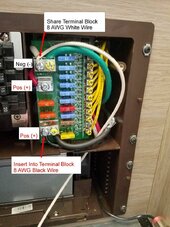Q-Dog
¯\_(ツ)_/¯
It is possible this is just a common bond (ground) location for all of the different electrical systems they might install into their RVs. I would assume Winnebago understands how to do this after making more than a couple of RVs. Measure the voltage drop if you think there is a problem ... let us know what you find. Theory and practice don't always match up.
I had a bunch of other stuff here, but I'm done now.
I had a bunch of other stuff here, but I'm done now.




